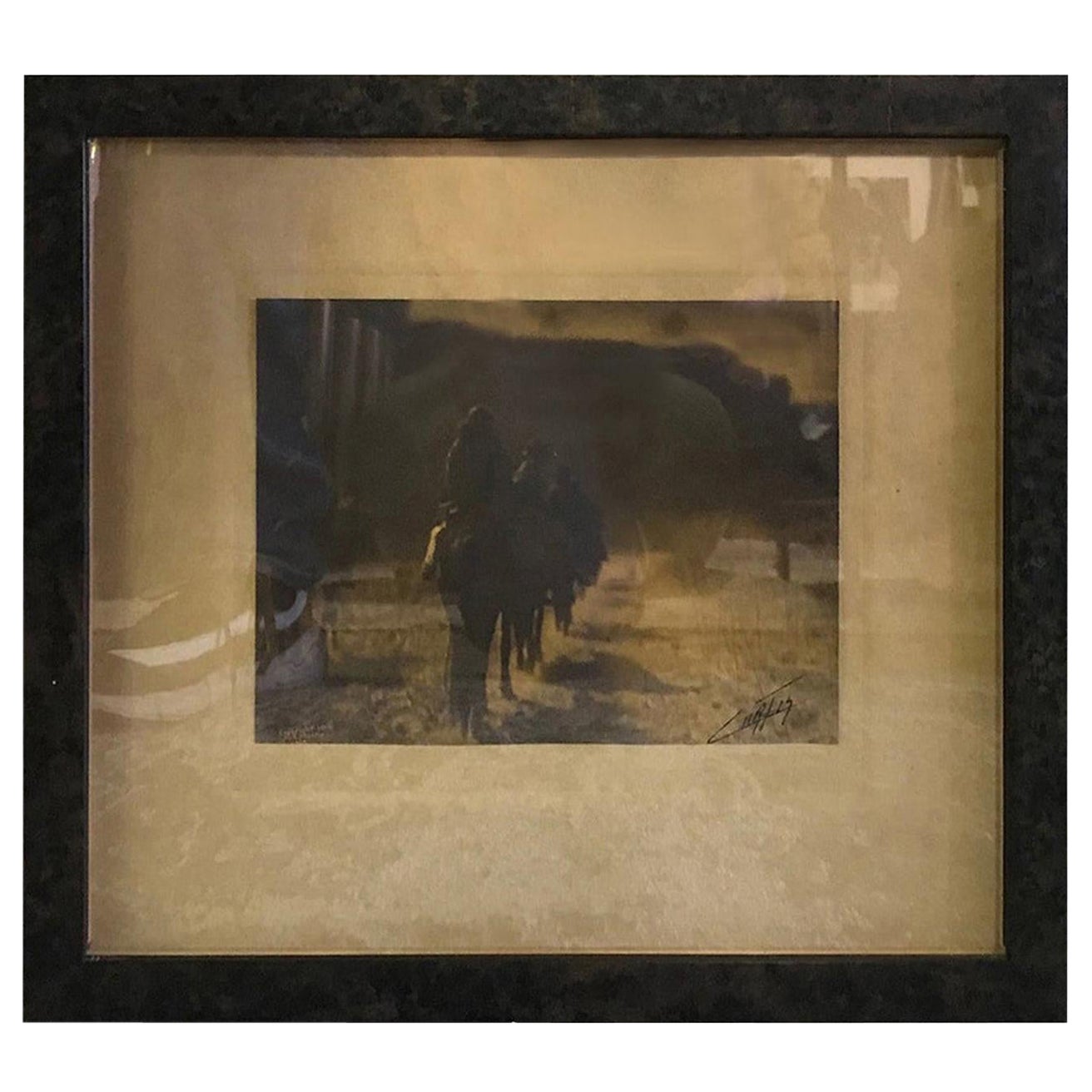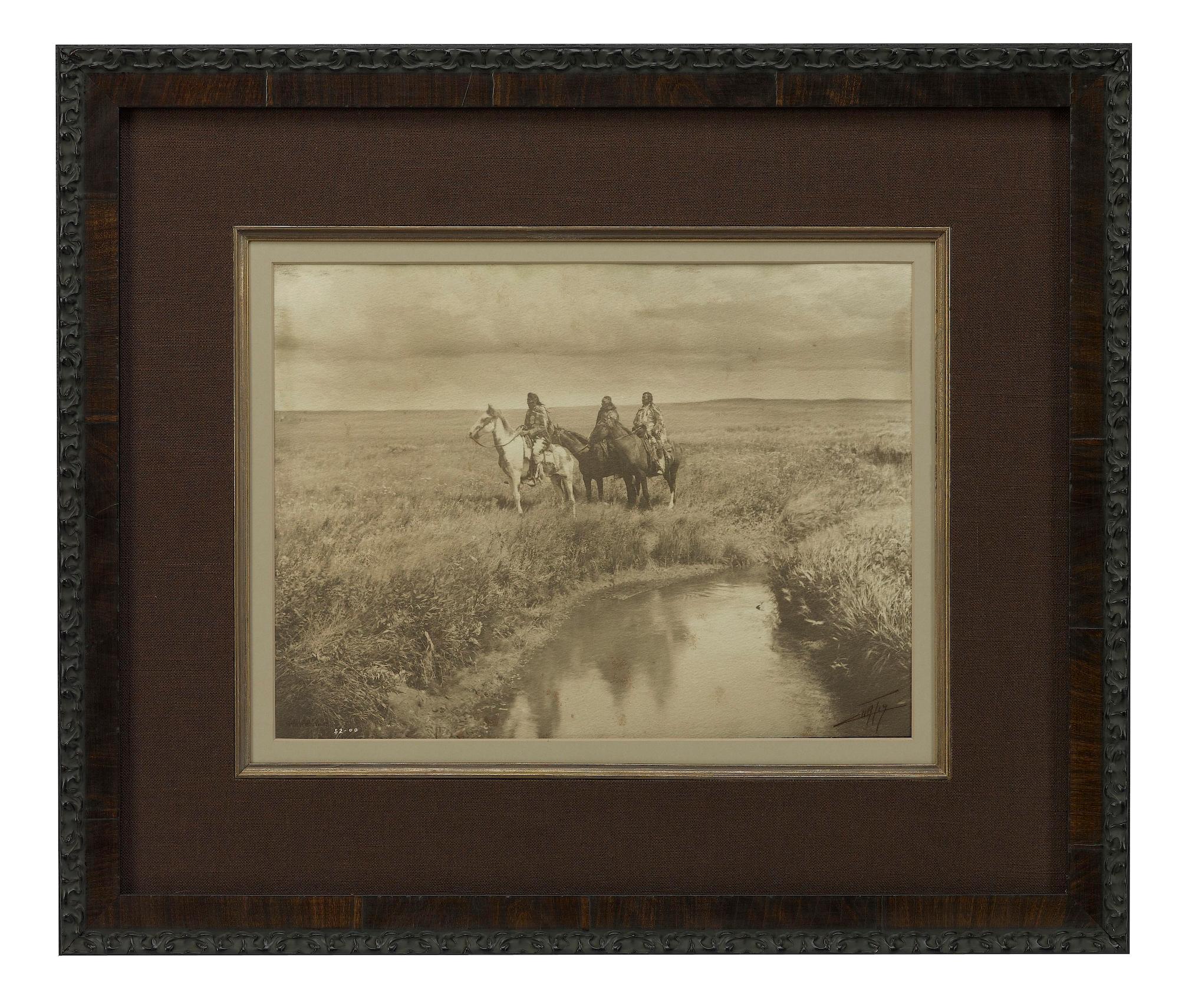Edward S. Curtis Original Signed and Stamped Silver Toned Platinum Print, 1906
About the Item
- Creator:Edward S. Curtis, 1868-1952 (Photographer)
- Dimensions:Height: 13.5 in (34.29 cm)Width: 11.5 in (29.21 cm)Depth: 1 in (2.54 cm)
- Style:Native American (In the Style Of)
- Materials and Techniques:
- Place of Origin:
- Period:1900-1909
- Date of Manufacture:1906
- Condition:The print is in very good vintage condition. The frame may have some light natural wear consistent with age and use (please see photos). A rare and hard to find work over all.
- Seller Location:Studio City, CA
- Reference Number:1stDibs: LU2254310724013
Edward S. Curtis, 1868-1952
Edward S. Curtis is arguably the most influential photographer of the American West. His work unquestionably ranks among that of the most important photographers of the 20th century.
Curtis was first and foremost; an extremely gifted and sophisticated artist whose work had the duality of being an incredible artistic creation at the same time as being a document of a people. He was uniquely able to create, out of whole cloth, a lasting vision of the American Indian that never existed before it was first seen through his photographic lens.
Edward Curtis produced images of the American Indian that convey a dignity, a universal humanity and a certain remaining majesty that transcend literally all other work ever done on the subject. In his photographs we see images that are uniquely able to stand alone in the world of photography.
Beginning in 1898 and continuing through 1928, Curtis dedicated his life to documenting the traditional lifeways and cultures of 128 American Indian tribes living west of the Mississippi River, from Alaska to the Mexican border.
Curtis was a genius of an artist possessed by a singular obsession to preserve the traditional lifeways of the American Indian.
Astonishingly, focusing all his immense talents over a staggering 30-year period, Curtis accomplished what he set out to do; he did save the traditional lifeways of these Native Peoples but at tremendous personal cost. It cost him his marriage, it cost him his health, and it cost him any possible financial stability he might ever have had.
In spite of all this, he persevered and left a body of work never to be equaled in the field of photography.
Find authentic Edward S. Curtis photography on 1stDibs.
(Biography provided by Bruce Kapson Gallery)
- ShippingRetrieving quote...Ships From: Studio City, CA
- Return PolicyA return for this item may be initiated within 7 days of delivery.
- Edward S. Curtis Original Signed Stamped Platinum Print the Vanishing Race, 1904By Edward S. Curtis, 1868-1952Located in Studio City, CA"The Vanishing Race" is perhaps the most iconic and sought-after photographic print by renowned American artist Edward S. Curtis who was famed for h...Category
Antique Early 1900s American Native American Photography
MaterialsPaper
- Edward S. Curtis Original Signed Stamped Platinum Photograph Hopi Weaver, 1899By Edward S. Curtis, 1868-1952Located in Studio City, CAAn original platinum print on textured paper by iconic American photographer Edward Curtis titled "Hopi Weaver"(sometimes known as "The Weaver"). Curtis was famed for his work with the Native American peoples of the American West at the turn of the century. This image features a male Hopi elder weaving a blanket - an exclusively masculine occupation at the time. This platinum print is hand-signed in ink, blind-stamped with Curtis' embossed studio copyright stamp, and dated 1899. The negative number ("X 743") can possibly also be imperceptibly/faintly seen written by Curtis on the lower-left edge. The photo is mounted on a single, handmade lightweight paper typical of other mounted Curtis photos...Category
Antique 1890s American Native American Photography
MaterialsWood, Paper
- Rocky Schenck Signed Toned Silver Gelatin Photograph Print Nude with CrutchesBy Rocky SchenckLocated in Studio City, CAA wonderful and evocative work by Texas artist/ photographer Rocky Schenck. Schenck's beautiful, dream-like, ethereal images can be found in private collections, museums, and gall...Category
Vintage 1980s American Modern Photography
MaterialsPaper
- Large Signed Native American Hopi Original Mudhead Kachina Katsina Doll on StandBy Native American ArtLocated in Studio City, CAA wonderfully handcrafted/detailed and decorated Native American Hopi Mudhead Kachina doll. Quite an unusually large work. A striking piece overall. Hand painted with leather and possibly turquoise (necklace) accompaniment. Hopi katsina figures, also known as kachina dolls, are figures carved, typically from cottonwood root by the Hopi people. Initially, kachina dolls were made to instruct young girls and new brides about katsinas or katsinam, the immortal beings that bring rain, control other aspects of the natural world and society, and act as messengers between humans and the spirit world. The Mudhead or Koyemsi figure is viewed as a clown/joker figure who is responsible for laughter and entertainment at Hopi dances and ceremonial events. He plays drums and games to keep his audience engaged. The piece is signed by the artist under the base. From an extensive collection of Native American objects and artifacts. Would be a great addition to any Native American Art...Category
20th Century American Native American Native American Objects
MaterialsLeather, Wood, Paint
- Graham Nash Signed Silver Gelatin Photograph Print "Why?", 2003Located in Studio City, CAAn engaging photographic image by famed British musician and photographer Graham Nash (from the folk-rock supergroups Crosby, Stills & Nash and Crosby, Stills, Nash & Young). Nash's ...Category
Early 2000s American Modern Photography
MaterialsWood, Paper
- Jan Saudek Signed Silver Gelatin Photographic Print "A Maidservant's Story"By Jan SaudekLocated in Studio City, CAA riveting, early, limited edition photographic print by internationally renowned Czechoslovakian art photographer Jan Saudek. This print is signed, dated (1977) and numbered (8 of 2...Category
Vintage 1970s Czech Modern Photography
MaterialsPaper
- "Three Chiefs, Blackfoot, Montana" by Edward S. Curtis, Platinum Print, 1900By Edward S. Curtis, 1868-1952Located in Colorado Springs, COPresented is a rare, platinum Master Exhibition Print of Edward Curtis’ The Three Chiefs. Typical of Curtis’ Master Exhibition Prints, this platinum print is double-mounted, signed, with an embossed copyright credit and date stamp. His numeric notation “52-00” is in the photographic negative. Curtis photographed The Three Chiefs during his two weeks on a Blackfoot reservation in the summer of 1900. The photograph depicts three Piegan men in traditional dress on horseback, situated next to a small stream with an expansive cloud-filled sky behind them. The Piegans were the largest group in the Blackfoot Confederacy and still retained a majority of their original culture when Curtis visited the tribe. It reportedly took Curtis several days to find the perfect prairie backdrop and riders for this photo, yet his patience paid off. The image was pivotal in enabling Curtis to form his vision for his next project - his ambitious 20 volumes “North American Indian”publication. This print is believed to be one of only three oversized, platinum Master Exhibition Prints of this image in existence. It was printed by Curtis specifically for his East Coast exhibition tour of 1905-1906. Curtis chose only a small number of what he believed to be his finest negatives to produce prints for the show. He never again mounted an exhibition of his work, nor produced such distinctive, large-format platinum prints. “The extraordinary rarity of The Three Chiefs becomes clearer when viewed in the context of other Master Exhibition Prints, principally the 108 in the Peabody Essex Museum in Salem, Massachusetts, the largest collection in existence. The Museum, however, is missing a number of early, iconic images, including The Three Chiefs. It has long been assumed that these missing prints were held elsewhere, possibly in the collection of The New York Public Library. This theory has been substantiated by the Curtis scholar, Bruce Kapson, who unearthed a cache of letters from Curtis to J.P. Morgan and to Morgan's librarian, Ms. Bella da Costa Greene in the Pierpont Morgan Library archives in 2007. The correspondence establishes that 58 of the 100 prints in The New York Public Library's collection are actually Master Exhibition Prints, specifically selected by Curtis for J.P. Morgan as the best examples of his work. A typed letter, dated March 1907, from Ms. Greene to Curtis states: 'I enclose herewith a list of Indian photographs which you sent to Mr. J.P. Morgan'. The letter is accompanied by a handwritten list of 58 photographs, including The Three Chiefs (print number 52.) Morgan donated this group of prints to The New York Public Library in 1912.” (Christie’s Live Auction 1893 Catalog, 2007). Curtis’ platinum prints make up less than 1/2 of 1% of all of the work he created. Curtis’ platinum prints were created only for exhibition or direct sales to patrons and they were always made by Curtis himself. One significant dealer in Curtis prints...Category
Antique Early 1900s American Photography
MaterialsPaper
- "Juan Concho" Gold Tone by Carl MoonBy Carl MoonLocated in Coeur d'Alene, ID"Juan Concho" gold tone photograph signed by Carl Moon; 8" x 10". Published "In Search of the Wild Indian" by Tom Driebe on page 144. This piece is in the original frame; was displayed in Carl Moon's studio and passed to his son and daughter where purchased. A copy of the book "In Search of the Wild Indian" comes with; rare and exceptional. S OF CARL MOON 1903 to 1914 MS 285 Collection Guide Born in Wilmington, Ohio, Carl E. Moon learned his craft as an apprentice to a photography studio. He moved to Albuquerque, New Mexico, opened his own studio, and made pictorial studies of Indians in the region. Between 1907 to 1914, he worked for Fred Harvey...Category
Vintage 1910s American Native American Photography
MaterialsOther
- Original Edward S. Curtis Photogravure, "The Klamath Hunter" 1923By Edward S. Curtis, 1868-1952Located in Colorado Springs, COPresented is a beautiful photogravure showing a Klamath man hunting from a dugout canoe. This image is Plate 458 from Volume 13 of Edward Curtis' epic project The North American Indi...Category
Vintage 1920s American Photography
MaterialsPaper
- "Porcupine - Cheyenne" by Edward S. Curtis, 1911By Edward S. Curtis, 1868-1952Located in Colorado Springs, COPresented is a fine photogravure portrait of a Cheyenne man with cottonwood leave headdress by Edward Curtis. The image is Plate 216 from Supplementary Portfolio 6 of Edward Curtis' ...Category
Vintage 1910s American Photography
MaterialsPaper
- "Ogalala Woman" by Edward S. Curtis, 1908By Edward S. Curtis, 1868-1952Located in Colorado Springs, COPresented is a fine photogravure portrait of an Ogalala woman by Edward Curtis. The image is Plate 94 from Supplementary Portfolio 3 of Edward Curtis' epic project The North American...Category
Antique Early 1900s American Photography
MaterialsPaper
- "Wildflowers" Gold Tone by Carl MoonBy Carl MoonLocated in Coeur d'Alene, IDSigned Goldtone; 8" x 10"; Taos, 1914; also titled "Pueblo Belle, First Mesa"; published in "In Search of the Wild Indian" by Tom Driebe on page 110. This piece is in the original frame; was displayed in Carl Moon's studio and passed to his son and daughter where purchased. A copy of the book comes with; rare and exceptional. Born in Wilmington, Ohio, Carl E. Moon learned his craft as an apprentice to a photography studio. He moved to Albuquerque, New Mexico, opened his own studio, and made pictorial studies of Indians in the region. Between 1907 to 1914, he worked for Fred Harvey...Category
Vintage 1910s Photography
MaterialsOther






